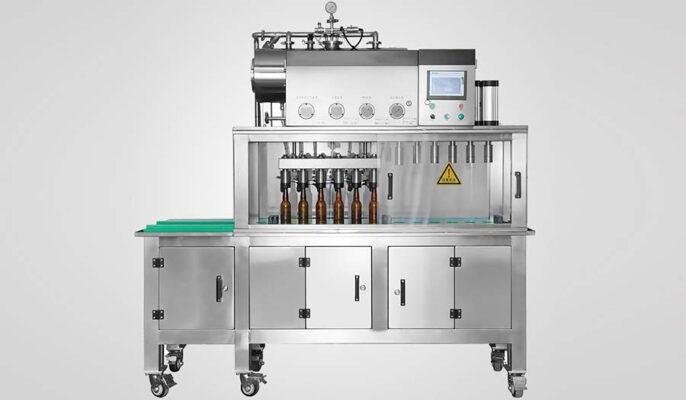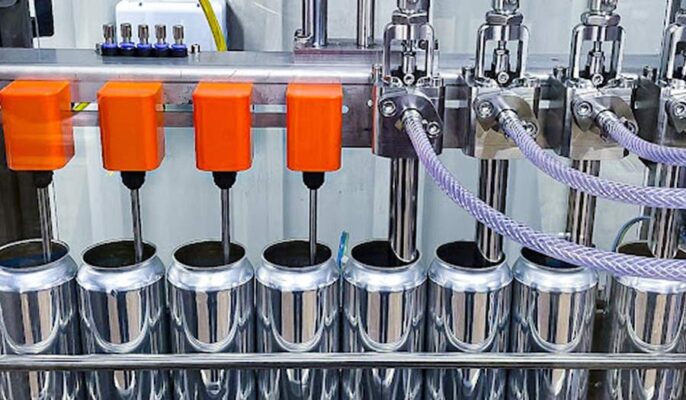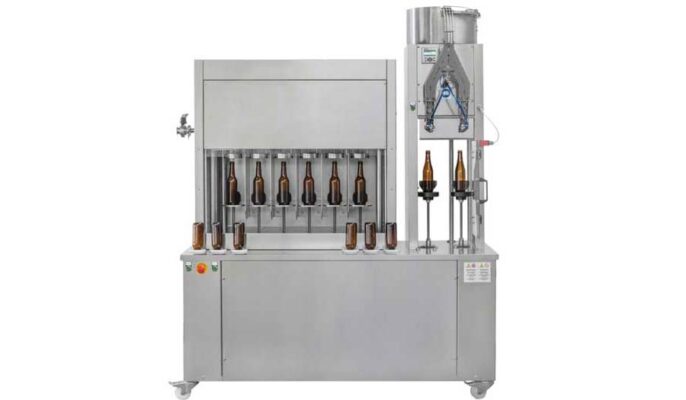Beer filling equipment is essential for beer production, allowing efficient and high-quality filling of beer into cans, bottles, kegs, and other containers. This equipment guides the beer from fermentation or storage tanks through cleaning, filling, sealing, and packaging processes. With the rising popularity of craft beers and microbreweries, having the right filling equipment is key to meeting production targets.
This guide provides a detailed overview of the common types of beer filling equipment, their working, selection factors, top suppliers, installation and operation guidelines, maintenance tips, and pros and cons of different setups. Whether you are starting a new microbrewery or upgrading your filling line, this guide will help you find the best equipment as per your needs and budget.
Overview of Beer Filling Equipment
Beer filling equipment includes a wide range of machines and components to handle tasks from cleaning containers to filling, crowning, seaming, labeling, packing finished products. The main equipment types are:
| Equipment Type | Functions |
|---|---|
| Bottle washers | Cleaning bottles through spraying, soaking, brushing |
| Bottle fillers | Filling bottles with beer under pressure or gravity |
| Can fillers | Filling cans with foam-free beer under pressure |
| Keg fillers and cleaners | Filling and cleaning kegs, casks |
| Cappers | Applying crowns/caps on bottles |
| Seamers | Seaming cans and other containers |
| Labellers | High-speed application of front, back, neck labels |
| Packaging | Wrapping bottles in cartons, packaging into boxes |
The filling equipment setup typically includes:
- Filler machine accepting containers from conveyor
- Buffer tanks storing filtered beer
- Pipes, valves, flow meters controlling beer flow
- CO2 system providing inert gas blanket
- Control panel to set filling parameters
- Reject system for defective containers
- Infeed and outfeed conveyors
Additional components like rinsers, crowning machines, pasteurizers may be integrated into the line depending on production needs. The next sections examine the working, selection, operation, and maintenance of key filling equipment types in detail.

Beer Bottle Fillers
Bottle fillers allow rapid, high-volume filling of glass beer bottles while maintaining beer quality and preventing foaming/overflow. They fill bottles through gravity or under pressure using volumetric or time-pressure filling methods.
Types of Bottle Fillers
| Filler Type | Method | Throughput | Foam Control | Cost |
|---|---|---|---|---|
| Gravity filler | Beer flows into bottles under gravity | Slow | Poor | Low |
| Piston filler | Intermittent pressure filling | Moderate | Good | Moderate |
| Rotary filler | Continuous pressure filling | Very high | Excellent | High |
Gravity Fillers
In gravity fillers, beer flows into bottles from overhead tanks relying on gravity. Flow rate is controlled through a valve below the tank. They have low throughput and poorer foam control than pressurized fillers. Used for small scale productions.
Piston Fillers
Have a piston inside every filling valve providing intermittent pressure on the beer. Allows better speed and foam control versus simple gravity. Used by microbreweries producing up to 30,000 bottles/hour.
Rotary Fillers
High-speed fillers with a rotating table to index bottles under filling nozzles. Nozzles fill each bottle in turn under continuous pressure providing excellent fill accuracy and foam control. Widely used by large scale bottling plants with speeds over 60,000 bph.
Bottle Filler Capacity
| Production Scale | Bottles per hour |
|---|---|
| Small brewpub | 100-500 |
| Microbrewery | 1000-15000 |
| Regional brewery | 20000-50000 |
| National brewery | 60000-100000 |
Bottle filler output is selected based on the planned production volumes and peak capacity needs. A modular filler machine allows adding more filling valves and tooling later for higher throughputs.
Bottle Filler Design
Key aspects of filler design include:
- Cleaning – Bottle infeed has rinsers, internal & external bottle washers
- Filling – Carousel/rotary design with filling valves and level sensors
- Sealing – Integrated crowning, seaming, labeling stations
- Rejection – Outfeed checks filled volumes and diverts defects
- Control – PLC based control panel, HMI touchscreen
- Mobile – Casters for portability (for microbreweries)
- CIP – Cleaning in place for filtration, tanks, pipes
- Customization – Custom filling valves, bottle guides for specials
Factors In Selecting Bottle Fillers
| Parameter | Considerations |
|---|---|
| Speed | Production volumes, peak capacity needs |
| Accuracy | Foam control needs, beer type |
| Automation | Level for manual intervention at each stage |
| Size | Footprint, height constraints |
| Budget | Available capital expenditure |
| Support | Installation, operator training needs |
Select fuller automation based on labor costs versus capital expenditure budgets. Evaluate filler accuracy needs based on beer type – highly carbonated beers need better foam control.

Top Beer Bottle Filler Manufacturers
| Company | Popular Models | Prices |
|---|---|---|
| KHS | Innosept Asbofill, Modulfill | $$$ |
| Krones | Variofil, Sleevematic | $$$ |
| Alfa Laval | ROSA | $$ |
| GEA | Flashpasteurizer, Autoclave FT74 | $$$ |
| IC Filling Systems | GF12 Micro, GF18 Compact | $$ |
| US Beer Systems | 2Head Bottle Filler ECO-2 | $ |
KHS Innosept Asbofill
High-speed aseptic rotary bottle filler capable of handling up to 160,000 bottles per hour. Excellent sterile conditions and durability. Top choice for national breweries with very large batches.
Krones Variofil Range
Modular rotary fillers customized to handle 3,000 – 80,000 bottles per hour. Lower throughput variants work well for microbreweries and connoisseur beers.
Alfa Laval ROSA Standard
Compact linear piston filler provides accurate fill levels up to 15,000 bottles per hour. Affordable automation ideal for small craft breweries and rural microbreweries.
IC Filling GF Range
Affordable piston fillers from Italian manufacturer IC Filling handle 100 to 30,000 bottles per hour. Low cost of ownership and good fill accuracy suits small rural microbreweries.
Installing Beer Bottle Fillers
Proper installation by trained technicians ensures long equipment life, safety, and efficiency targets. Below are key installation steps:
| Activity | Details |
|---|---|
| Site preparation | Level foundation, floor drains, power lines ready |
| Uncrating | Unpack and inspect filler parts |
| Positioning | Assemble/weld frame, position machine |
| Levelling | Use hydraulic jacks, spirit level for precise alignment |
| Utilities | Connect steam, air, water, CO2 lines |
| Electricals | Install control panel, sensors, field devices |
| Test run | Check directional motions, interlocks |
| Trial batch | Validate fill precision, production rates |
Leave sufficient access space around the filler for maintenance and sanitization. Ensure stable voltage without spikes that can impact PLC operation.
Operating Beer Bottle Fillers
Efficient standard operating procedures result in lower product losses, wastage, higher uptime. Below are best practices:
| Activity | Best Practices |
|---|---|
| Startup | Verify CIP done, lines fully drained<br>Check lubrication levels |
| Filling | Monitor overall equipment efficiency (OEE)<br>Track rejected bottle count |
| Changeover | Implement SMED for faster product changeovers |
| CIP | Daily CIP mandatory between product batches |
| Handling jams | Isolate, purge lines<br>Carefully access cleared bottles |
| Shutdown | Rinse, drain lines fully<br>Turn off utilities last |
Follow detailed SOPs covering every activity like manual CIP, preventive maintenance, calibration of instrumentation etc. Maintain operation logbook recording efficiency metrics, downtimes, production volumes shiftwise.
Maintaining Beer Bottle Fillers
A checklist covering cleaning, lubrication, inspections helps maximize uptime. Critical aspects:
- Schedule preventive maintenance before production season
- Daily air filter cleaning, check oil levels
- Fortnightly belt tensioning, chain lubrication
- Quarterly replace seals, valves, gaskets proactively
- Annual major overhaul, electrical insulation testing
Factors Impacting Bottle Filler Effectiveness
The working and efficiency of a bottle filler depends on various technical and operational parameters. Understanding these factors helps optimize selection as well as day-to-day operation.
Impact of Beer Properties
Beer characteristics like dissolved CO2 levels, viscosity, foaminess determine appropriate filler design. For example, highly carbonated beers require superior foam control through specialized filling nozzles. Viscous beers may demand pressurized filling versus simpler gravity filling.
Role of Filling Valves
Filling valves control the beer flow into bottles and prevent foaming/turbulence. Special valves are required for highly carbonated beers and minimal oxygen uptake. The number of filling valves limit maximum line capacity.
Influence of Automation Level
Higher automation systems have features like automatic bottle rejection, self-diagnostics, advanced operator controls. This allows minimizing human errors and reduces staff training overheads. Intelligent fillers adjust filling parameters based on inline quality checks to ensure uniform fill levels.
Impact of Cleaning and Sanitation
Stringent cleaning-in-place (CIP) maintenance between batches using caustics, hot water/steam sterilization is essential. Insufficient cleaning can lead to bacterial build up affecting shelf life. Advanced systems have CIP automation, sterilizationtunnels integrated before filling.
Importance of Line Integration
Efficiency improves when the filler is seamlessly integrated with upstream equipment like labellers, cappers and downstream packaging stations through conveyors and product handling systems. Bottleneck at any point disrupts the entire line performance.
Influence of Container Parameters
The shape, size, mouth diameter and material of bottles can necessitate customizations to filler parts like change parts, guides, spin heads. Different bottle dimensions may need format changeover to adjust filling valves, sensors and downstream equipment like labelers.
Advanced Technologies for Beer Fillers
Innovations in technologies like automation, digitalization and analytics are helping take filler productivity, precision, line efficiency and data visibility to the next level.
Integrating IIoT Sensors
IIoT sensors for temperature, pressure, flow, CO2 allow advanced monitoring fromanywhere. Predictive analytics tools give actionable insights to optimize filler performance.
Incorporating Industrial AI
AI powered visual inspection accurately flags defective bottles for removal. Intelligent filler algorithms memorize ideal settings for different beer types. This allows fully optimized changeovers.
Adding Augmented Reality
Smart glasses guide technicians for complex filler troubleshooting, preventive maintenance using AR overlays. This reduces maintenance costs through fewer errors and faster problem resolution.
Shift to EMI over Pneumatics
Electro-mechanical actuation (EMI) fillers gain popularity for their higher precision, energy efficiency and lower noise versus conventional pneumatic systems. EMI fillers have 25% higher filling accuracy.
High Speed In-Line Monitoring
Innovations like high resolution cameras, lasers and X-ray provide high speed in-line inspection to check fill levels, cap placement etc. This allows identifying issues before packaging to minimize losses.
Procurement Guide for Beer Bottle Fillers
Investing in a new filler involves substantial expenditure over $100,000 for a high-end machine. Careful procurement planning considering below factors results in picking the ideal filler at the best price.
Developing Precise Specifications
Throughput rates, floor space, integration needs, filler features must align with planned production scale, site constraints and quality goals.
Researching Various Vendor Options
Create a list of major brands and compare machine specs versus needs. Shortlist 3-5 filters best matching requirements. Ask for references of installations of similar scale.
Comparing Quotes in Detail
Evaluate quotes from shortlisted vendors in depth based on warranty, service support, spare part costs, ease of operation and total cost of ownership besides just machine pricing.
Validating Supplier Credentials
Validate company history, financial stability, support infrastructure before finalizing supplier. Check they have successfully implemented projects of similar complexity earlier.
Finalizing Payment Terms
Structure vendor payments with installments linked to delivery, installation, trial runs and final handover to build in accountability. Withhold 20-30% payment until satisfactory project completion.
Careful procurement following above guidelines prevents project delays, long-term headaches and saves substantial dollars in the long run.

FAQs
Below are some common questions raised regarding selecting and operating beer filling machines:
Q1. What throughput scale filler should I get for a microbrewery making 5000 liters annually?
A1. A compact linear piston filler with 4-6 nozzles like Alfa Laval ROSA Standard capable of 4,000 – 7,500 bph (beers per hour) will be ideal. It will have expansion possibilities for adding more filling heads in future as production scales up.
Q2. Can I shift my filler from bottling beer to filling wine bottles without issues?
A2. You will need change parts for guides, valves, level sensors to handle the new bottle dimensions but filler materials will be compatible. So yes shifting between beer and wine filling is definitely feasible.
Q3. How much beer loss should be expected during first-time filler setup?
A3. If filler setup is done properly by an experienced technician and test batches are validated before starting production, losses can be as low as 1-1.5% during first month operation. Losses should stabilize under 1% over long term.
Q4. How much space do I need to accommodate a filler in my brewery?
A4. Depending on your target capacity, filler footprint can be as low as 4’ x 3’ for a compact entry level machine up to 15’x8’ for an high-end industrial scale filler. Add space provisioning for storage tanks, conveyors based on layout plans.
Q5. Can normal tap water be used for bottle cleaning in fillers?
A5. No, only purified soft water must be used for bottle rinsing and cleaning-in-place in fillers. Hard water leads to mineral deposition affecting cleaning efficacy and beer quality. Invest in a water purification system if tap water supply is hard.




